 By Pepper Parr
By Pepper Parr
July 8thth, 2025
BURLINGTON, ON
Katie Lebel delegated at City Hall on behalf of the Burlington Aquatic Devilrays
I’ve been asked to speak on behalf of the Burlington Aquatic Devilrays. I am a Burlington resident, a sport business professor, and the proud parent of a young swimmer on the team.
I’m also a former competitive swimmer. My sister and I grew up swimming under Head Coach Sergei Soloukhin more than 25 years ago. Now, I have the privilege of watching my daughter fall in love with the same sport—under the same coach who helped shape who I’ve become.
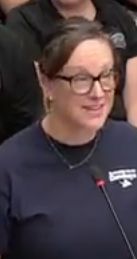
Katie Lebel
I’ve delivered talks around the world on the power of sport. But I’m not sure I’ve ever spoken with more at stake than I do today. What’s at risk isn’t just pool time—it’s community, continuity, and the systems we count on to support our children and protect what matters in civic life.
We are here because we believe a better way forward is still possible.
While we did file for judicial review after our proposal was rejected without evaluation, we paused that process in good faith, because we believe a collaborative solution is still possible.
We’re not asking for special treatment. We are here to advocate for fairness, for transparency, and for a shared-use model that reflects Burlington’s values.
The Burlington Aquatic Devilrays is a not-for-profit, volunteer-led swim club with a 40-year history in this city. We serve over 400 swimmers from across Burlington and surrounding communities.
We’ve raised money for the Terry Fox Foundation, the Burlington Food Bank, and the Compassion Society. We don’t just use public resources—we help build and sustain them. We’ve welcomed national-level athletes and complete beginners. We’ve kept our programs affordable. And we’ve remained rooted in the community, season after season, for four decades.
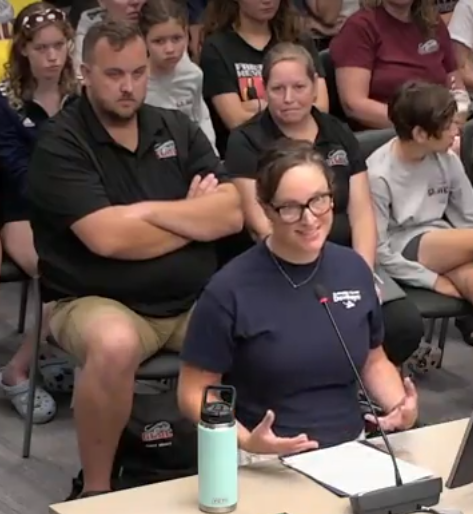
Katie Lebel delegating to Council for BAD. Sitting immediately behind her is Cody Bradt – Associate Head Coach & Chief Operating Officer who later delegated for the GHAC
That legacy—everything we’ve built—was destabilized by a process that disqualified our proposal over a document that doesn’t exist in the form requested.
The language in the RFP asked for a “current and valid certificate of incorporation”—a document that, in Ontario, is not re-issued after initial incorporation. What’s typically used to verify legal status is a Certificate of Status or a Corporation Profile Report from Service Ontario. This technical ambiguity in language had real consequences: our proposal was rejected outright, without review.
The result was not a level playing field. It’s a signal that the process, while well- intentioned, may not be aligned with the realities of youth sport.
We met every substantive expectation laid out in the RFP, But we were disqualified before these strengths could even be considered or evaluated.
the RFP model is not designed to capture the depth of community relationships, the value of consistency for youth, or the contribution of legacy volunteer-run organizations. To our knowledge, competitive swimming is the only youth stream in Burlington currently operating under an RFP process. That fact alone suggests we need to stop and reconsider.
And all the while, time is running out.
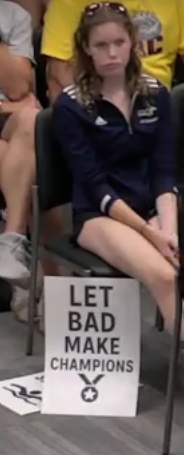
A BAD swimmer
Every day that passes, more families leave. More swimmers ask if they’ll have a team. Our coaches can’t plan. Our registration is late. Just two weeks ago, our club was riding high.
We had just hosted two outdoor swim meets—one for our senior athletes, which welcomed 14 clubs, including one from Newfoundland. And another for our novice and precompetitive swimmers—just our own athletes—who got to experience the thrill of racing, many for the first time.
No child should ever have to worry about losing their community.
In youth sport, ‘do no harm’ should be the baseline. But when a team is destabilized— when kids lose their teammates, coaches, and training rhythm, the familiarity of practice sites—it’s the swimmers who feel it first. It shakes their confidence, interrupts their development, and undermines their sense of belonging.
Our senior swimmers train six days a week, often twice a day. They’re not just athletes, they’re leaders in our club who mentor younger teammates and help shape the club culture.
Disrupting those relationships carries real emotional and developmental cost.
Our club reputation, built over decades, has been put at risk by a process that did not allow us to be evaluated.
this decision didn’t happen in a vacuum. What’s unfolding here reflects a broader shift in how sport is being delivered across Canada.
Our club reflects a community model: affordable, team-based, volunteer-run, and grounded in long-term athlete development.
In contrast, we’re seeing the rise of market-based models—regional, fee-for-service programs that function more like private providers than community-rooted teams.
This isn’t just about two swim teams. It’s about two different visions for youth sport. One prioritizes access, development, and community.
The other prioritizes flexibility, expansion, and the ability to scale—at a significantly higher cost to families.
That’s not just a pricing issue—it’s an equity issue.
These are public pools, built with public dollars, meant to serve the public good.
If we allocate that space without factoring in cost and accessibility, we risk excluding the very kids who need it most. Let’s not make affordability the casualty of process.
Procurement-style evaluations that ignore the difference between community and commercial models risk outsourcing youth development—not by design, but by default.
Yes, there’s room for both in our sport ecosystem. But giving public pool time to a fee-for-service provider should never come at the expense of a long-standing, community-based club that has served Burlington for over 40 years. That’s not innovation. That’s displacement.
If it can happen to us, it can happen to others—Teen Tour Band, youth hockey, gymnastics, student theatre. This is a precedent-setting moment.
This issue has reached far beyond our pool deck. It has mobilized parents, athletes, coaches, officials, volunteers, and community leaders — not just from Burlington, but across Ontario and beyond. Other community-based organizations are watching closely, too — because what happens here doesn’t just affect BAD. It sets a precedent for how legacy youth clubs across this city may be treated when they come up for renewal.
We understand that pool time decisions are operational, but the values that guide those decisions start with Council.
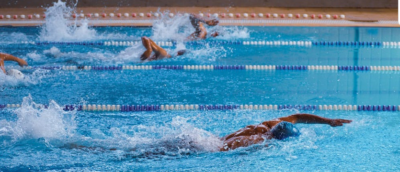
A competitive event – sponsored by BAD
So our ask is this: immediate stability—40 hours of pool time this fall. And longer-term, a better process for allocating public sport resources that reflects the realities of community-based youth programming.
This isn’t about being chosen over another club. It’s about being given a fair chance to be considered—something every community organization should expect when applying to use city-owned public facilities.
We’re asking you to lead—not just with policy, but with principle. It’s not too late to apply the simplest, most universal principle in situations like this: do no harm. Especially not to children, especially not through bureaucratic oversight.
This is your chance to send a message: that in Burlington, we protect legacy, we honour fairness, and we show up for our kids.
The delegation has been edited due to space restrictions and clarity.
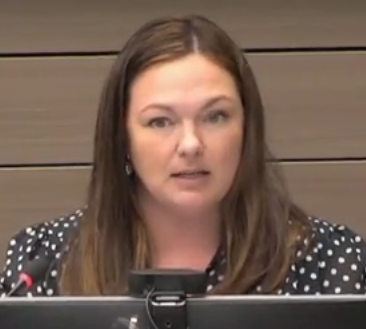
Chair of the Standing Committee that heard the delegations: Ward 2 Councillor Lisa Kearns.
Chair Lisa Kearns: Okay, so you’re going to pause. I’m going to look to committee for any questions. You’re going to stay and answer the questions. Okay, okay. You will not be asking questions of staff either. Don’t ask questions back. Okay?
Councillor Stolte: My question is around any advice you have for us, around a better process than an RFP to allocate scarce Pool time,
Lebel: a rental agreement at the end of the day. I think the RFP just does not capture the ability to there’s no waiting for community legacy, and I don’t think that it’s able to capture the difference between that community model versus the market based model that we’re starting to see show up, and that’s going to be a broader problem across sports, so potentially a pool rental procedure. I think there’s other ways. Historically, my understanding is that this is a relatively new process that’s been applied. It started in 2020 I’m not sure what was done, but sure what was done before that, but potentially going back, I do think there’s room for more, different models in our ecosystem. We have a wait list of over 150 swimmers. So there’s a there’s a huge demand for swimming, but I don’t think that we can have one at the expense of another.
Stolte: Well, are you and your I don’t know if you’re speaking for the club, but would you be willing to speak with our staff and other people who want access to Pool time to sort it out? That’s how we do it with some of the other sports is that a viable way forward?
Lebel: Yes, our goal is to protect the kids. This has been, horrific for these kids, and we need to do better for them.
Chair. Thank you so much for your delegation. I just wanted to ask a quick point of clarification. I’ll ask, to to expand on it. But did you say that it’s your understanding that it’s only the swim clubs that are put through this RFP program that is our understanding? If you go through the language, I’ve pored through this for the last week, it’s very much more of a construction contract, honestly, which is fine for some processes, but again, it just does not reflect youth sport
Councillor Bentivegna: Just a quick question with regards to follow up from Councillor Stolte prior to 2020 Can you tell us how things proceeded?
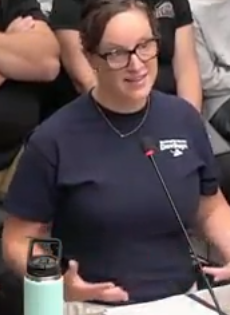
Katie Lebel
Lebel: Don’t have that history.
Bentivegna: Okay, so membership, how many swimmers?
Lebel: We’ve got 400. Our pool time program is based on the amount of the allocated time that we’re given by the city. We are not in a growth mindset. We’re doing what we can with the number of hours we’re provided by the city.
Bentivegna: 400 swimmers. Has that been consistent?
Lebel: Yes, we’ve got a wait list of swimmers now that’s divided up between pre competitive and competitive. We’ve got about 85 pre competitive swimmers. It’s generally competitive swimmers, and 85 not pre competitive.
Chair Kearns: Last question; I’m not sure if you can answer this, but if everything proceeds as is, what happens to that?
Lebel: I’m not sure we’re able to exist.
Chair Kearns: I’m going to ask one question of you; we’re going into closed session for potential update on litigation, as it says in the statement on the public agenda. In that regards, do you have any potential litigated, avenues that you’re looking to explore? Just a yes or no.
Lebel: Yes?
Chair Kearns: Okay, thank you very much. I don’t have any other questions for you as a delegate. Thank you for joining us.
Lebel: Thank you very much for the time to share our story.


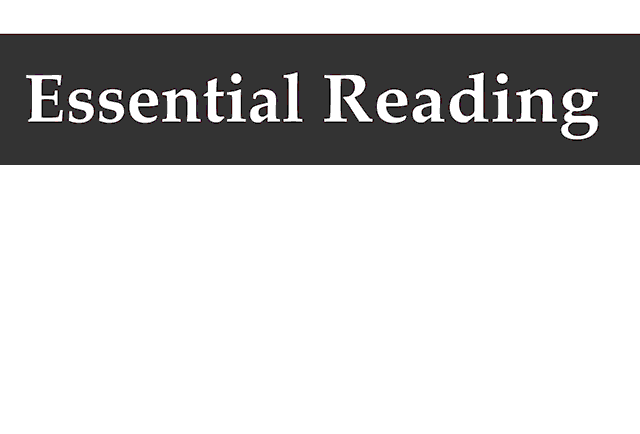












Bruce, I like your ironclad logic—clear, grounded, and refreshingly free of slogans. It’s not about who shouts the loudest or rallies the biggest crowd; it’s about who brings facts, fairness, and long-term vision to the table. Thank you for holding the conversation to a higher standard.
Hele,
It’s absolutely valid for families to care about access and affordability—but it’s important to clarify a few things.
First, the “dryland training” at BAD isn’t swim-specific. It is just an outsourced general fitness game-class. BAD also does not have any pre-swim activation. By contrast, GHAC integrates dryland before every practice 15-minute sessions before water, led by their coaching team and tailored to swimming development.
Second, your child currently swims 8 hours per week—an excellent developmental level. That kind of programming belongs in pools like Tansley Woods or Aldershot (those pools are not part of RFP), not high-performance facilities like Centennial or Angela Coughlan. Meanwhile, there are Burlington swimmers the same age as yours or younger waking at 4:00 a.m. and commuting over 200 km daily just to train—because BAD’s entry-level groups monopolized the city’s prime performance pool time.
Third, yes—all other clubs are more expensive than BAD. But so is quality. High-performance swimmers require experienced coaches, low lane density, structured dryland, and a performance pathway. That’s not “waste”—that’s investment. It’s how athletes break 500, 600, even 700 FINA points and stay injury-free doing it.
This isn’t just about where kids swim. It’s about aligning public resources with actual training needs. Warm pools should support fundamentals. Cold pools should serve high-performance athletes training 15+ hours per week. That’s fair. That’s efficient. That’s how you build a healthy swim ecosystem.
Let’s also be clear—over 80% of BAD swimmers are non-competitive. And most of BAD’s top performers? They’re long gone. They train in other clubs offering higher development standards. That’s not opinion—that’s Swim Canada data.
So yes, affordability matters. But framing this as a $100/month debate is reductive. The real costs of swimming—meet fees, travel, gear, recovery, and time—dwarf that figure. When your child becomes serious about this sport, your decisions won’t be driven by that $100. They’ll be driven by the quality of coaching, safety, culture, and long-term development.
And believe me—once your child starts logging 15+ hours a week and relying on her shoulders to carry her dreams, you’ll want another local option. Not BAD. One that will support her through those grueling years with expertise, care, and consistency.
Right now, Burlington’s truly competitive swimmers have no choice but to pay $450–$650 per month and commute 200 km per day. That’s not luxury—that’s necessity born from infrastructure imbalance.
Let’s also be honest about the so-called “BAD community.” It’s largely entry-level families moving in and out of the sport—often because it’s more affordable than private swim schools like Goldfish. And that’s okay—learn-to-swim access is important. But entry-level volume shouldn’t crowd out high-performance athletes who have dedicated years of discipline and sacrifice. City swim programs must serve the entire ladder of development—not just the first rung.
Also, why has Burlington’s competitive pool time been used for coaching non-resident beginners? According to city-submitted data, 21% of BAD’s “community” are not Burlington residents. That means City facilities—funded by Burlington taxpayers—were being used to teach entry-level swimmers from Oakville, Milton, and Hamilton (looking for cheaper option and better pools/ schedules), while our own high-performing Burlington athletes were forced to commute 200 km daily to find appropriate coaching environments. That’s not community service—it’s misallocation.
And finally—let’s not forget that for years, GHAC swimmers had no access to public pools. They swam after 9:00 p.m. in private facilities while Centennial and Angela Coughlan were blocked out. Many of those kids were just as fast—or faster—than your own. Why wasn’t fairness a concern back then?
Fairness should apply to all—not just to those holding the megaphone today.
Hi Caleb
First, I want to say that I agree, fairness should apply to all. I wasn’t part of the swim community in 2020 so can’t speak to what happened, but I say again, GHAC had an opportunity to protest, address city council, have their voices heard, but they chose not too. That isn’t BADs fault.
I also disagree with your comments about BAD being mostly entry level families. While I agree that my child is still in the development stage, I wouldn’t call the kids she swims with “entry level”. Most kids her age don’t devote 8 hours per week to any sport unless they are serious about it. You stated, “ when your child becomes serious about this sport”. You assume because she’s only swimming 8 hours per week that she isn’t serious about it. She absolutely is. She just hasn’t reached her full potential yet and will progress as she improves.
While 21% of BADs community may not be local, only 28% of GHACs community is. That is a big difference. Also, the prices I cited from GHAC’s website were for their non competitive stream of swimmers. They seem to have a large portion of their club devoted to “making swimming fun again” that stresses the importance of exercise and activity for healthy living. The competitive team, that seems to be by invitation only, does not have prices or training schedules listed, so I couldn’t accurately say what the price difference would be, but the price difference for what I cited, is $175 a month, so approximately $2000 per year. That isn’t just a drop in the bucket for most families. We also pay meet free’s, travel and gear on top of that, and those costs increase, the further she progresses. What I will also point out, is if a large portion of GHAC is also, non-competitive, they will also be using the cities best pools for what would be considered recreational programming.
Lastly, I only speak for myself, not for BAD or any of the other families, but I don’t really care where GHAC trains, give them Burlington pool time, I am not suggesting BAD be the only club in the city. In fact, I am all for there being many options. There is more than one hockey league, multiple soccer organizations, why shouldn’t swimming have that same luxury. We can co-exist. I don’t think that we should be forced to join another club when we are perfectly happy with where we are at currently. My hope is that both teams are able to access pool time for their swimmers.
Decision was made ,so why are we wasting Council time trying to negate the procurement process !!!!!!!!!!!!!! dangerous precedent by Council to intervene
Bruce Leigh, I am not sure why it was solely up to the BAD organization to advocate for a different system in 2020. GHAC claims that when they lost 150 swimmers in 2020, they accepted the decision and asked for feedback for the future. Why didn’t they fight for pool time and fairness in 2020? They chose to roll over and accept the city decision. BAD has chosen to fight for the swimmers within their organization, GHAC could have done the same. It was the clubs decision not to and that is on them. Placing blame on BAD for not fighting for fairness in 2020 when GHAC themselves did not take a stand is unfair.
The fee’s for GHAC are considerably higher for less pool time and no dry land training. While BAD swimmers currently pay $240 per month for 8 hours of pool time and 1 hour of dry land training, the GHAC website lists their fee’s as $415 per month for 7.5 hours of pool time and no dry land training. These fee’s are considerably higher and will have an impact on many of the families already swimming with BAD.
Your last statement about time being of the essence shows that you do not have an accurate understanding of how swim clubs work. Yes swimmers are leaving, yes there are alternatives available, but that window of availability is TIME LIMITED. That is what is driving swimmers to register elsewhere. Clubs only have as many spaces as they have pool time. Registration at all clubs opens to existing members first. Once current members are registered for the following season, the club can allocate any spaces remaining to new swimmers. Once those spaces are filled, they cannot take on any more swimmers. Meaning, if BAD is not able to find pool time, kids who want to swim in September have to act now, otherwise those spaces will be filled, possibly leaving them with no club to swim for. Most of the families that are leaving, as far as I am aware, are not registering with GHAC but trying to find space at other clubs. If the majority of BAD swimmers were happy to leave BAD and join GHAC, this wouldn’t even be an issue.
I cannot answer your question for GHAC. I can make a presumption which would be that GHAC having accepted the process back in 2020, it submitted its proposal and did not win. Unlike BAD in 2025 GHAC didn’t whine in 2020. It accepted the decision and moved on. Some people would say that is taking the high road.
In my opinion BAD is not fighting for the swimmers. It is fighting for itself; for its own survival, “wrapping itself in a flag” of child concern. The swimmers will be okay. They’ll join GHAC or another swim club
The way I read your final paragraph is that you totally agree that time is of the essence because swimmers or swimmers families are making decisions. So the longer this goes on the more decisions will it be made by swimmers that may well negatively impact both GHAC or BAD..
Lebel says:-
“We’re not asking for special treatment. We are here to advocate for fairness, for transparency, and for a shared-use model that reflects Burlington’s values.”
Hallelujah!
Where was this advocacy for a shared use model back in 2020 when it was awarded a 5-year exclusive arrangement at the expense of GHAC. Only now that the boot appears to be on the other foot does BAD look for a shared use model.
A shared use model is the perfect solution as far as fairness between providers is concerned. However, that would likely result in neither GHAC nor BAD being able to fully service the Burlington community.
“Yes, there’s room for both in our sport ecosystem. But giving public pool time to a fee-for-service provider should never come at the expense of a long-standing, community-based club that has served Burlington for over 40 years.”
That statement implies that BAD does not charge a fee for its services which of course it does.
Label also implies GHAC is a for-profit entity. It is not! It is clearly a non-profit organization very similar to a not-for-profits organization such as BAD.
BAD states it is a not-for-profit organization as if that puts it on higher moral ground than GHAC. On the other hand GHAC positions itself as a non-profit organization. Is there a difference. Here is one explanation of the difference that I’ve been able to find:-
“While often used interchangeably, “nonprofit” and “not-for-profit” have subtle differences. Generally, nonprofit (NPO) organizations are structured to benefit the public good, while not-for-profit (NFPO) organizations exist to benefit their members or a specific group, not necessarily the broader public.”
So it would seem GHAC has the broader public interest at heart. Whereas BAD does not. BAD has a narrower focus.
Label continues:-
“everything we’ve built—was destabilized by a process that disqualified our proposal over a document that doesn’t exist in the form requested.”
If this statement is correct, I’m not saying it is not, how was GHAC able to satisfy the RFP requirement? Having been awarded the contract one must assume GHAC did meet that requirement.
“And all the while, time is running out. Every day that passes, more families leave.”
Yes, time is of the essence. But Label’s statement demonstrates there are alternatives available to swimmers.